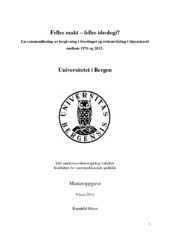| dc.description.abstract | The aim of this paper is to examine the relationship between the parliament and the Supreme Court in Norway. First, by studying the relationship between these two institutions on an institutional level, and secondly, try to explore if there is any reflection between the political party preferences when they implement a new law and the juridical votes when the judges apply the law in practice. The research question is interesting because it is determined in the Constitution of Norway, that one of the most important fundamental factors of the democracy of Norway is the balance of power. This balance of power should be divided into three different branches: The Parliament, the Government and the Supreme Court. There have been many changes in the society in Norway as well as on the international arena since the constitution of Norway was written 200 years ago. These changes have made the Supreme Court in Norway more influential, and a more realistic way to see how the power of balance in Norway really works, is to see the Government and the Supreme Court as one branch, where they share one power. Especially when the judges are present in the plenary (plenumssaker), and they are practicing prøvingsretten" the Supreme Court are acting like a political institution. I make a case study of this relationship to understand the mechanisms of how the relationship between the Government and the Supreme Court works. By reading every plenumssak" between 1976-2013, in all 62 cases and amount of reports of the political discussion when the law used in the plenumssak" was implemented in the Parliament, I found a basis for a comparison between the political discussion and the voting of the judges. The analysis confirms that the Parliament and Supreme Court have a mutual dependency in their relationship. They are not only sharing one of the power branches, they are also sharing the same ideology. A majority of the judges that I could find an ideological tendency of their voting records are voting social democratic. In my analysis I also compared my results with the results that Grendstad et. al(2011c) got in their study of the ideological point of view the judges in the Supreme Court to confirm or deny my results. | en_US |
